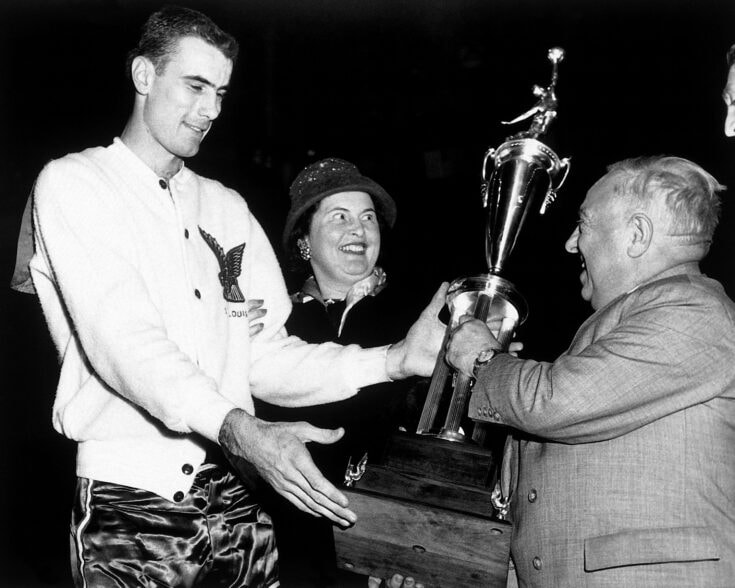
Bob Pettit defined the modern power forward position, and in doing so set standards that had never-before been reached in professional basketball. The first to 20,000 career points, the first to score 50 in a championship game, the first to win the Most Valuable Player award, Pettit blazed a trail for the truly remarkable power forwards that would follow.
Here stands Pettit’s career in visual form. From his eternal performance in the 1958 Finals against the Boston Celtics, to his unmatched approach to the All-Star Game, to the never-before-seen extended clips from the night he reached a scoring milestone, Pettit’s legacy and imprint will no longer be confined to either the memories of those who saw him or to the record books. The very best of it will reside here.
Pettit’s career began in 1954 with the Milwaukee Hawks. The league was still in its infancy, and it was a time of limited television exposure and scarcely retained film. What we do know is Pettit’s game was quickly seen to be highlighted by a sharp diversity. He was proficient facing the basket, an expert shooter from distance and also one capable of driving to finish at the basket – a practitioner of great skill for his size. Alternatively, he would use brute force under the basket to secure rebounds, particularly enjoying those garnered at the offensive end, by using the paint as a proving ground with an undying pursuit for the ball. For defenders, Pettit could demoralize with finesse and force.
Just how exactly did Pettit develop into one of the game’s greatest forwards? Here, in his own words, Pettit details the early obstacles he faced, a positional change that served as a springboard in his development, and the elements of the game that he enjoyed most.

If a player’s career legacy can be traced to a single championship game, then they’ve likely reached immortality. That is the case with Bob Pettit, and his masterpiece was Game 6 of the 1958 Finals against Boston. The Hawks (now of St. Louis) had lost to the Celtics the previous season, 1957, in what can safely be considered the league’s first iconic championship series, with the seventh game decided in double overtime.
The teams came together again in 1958 and the Hawks held a 3-2 lead entering the sixth game in St. Louis. Pettit’s game was characterized by a unique persistence and determination, and it was never exhibited greater than here. In Game 6, he simply refused to succumb. In the fourth quarter Pettit scored 19 of his team’s final 21 points and finished with 50. And the Hawks needed every one of them. The final was 110-109, and it would be another nine years before Bill Russell and the Celtics would allow another team the honor of being called champion.
A note for the lovers of historical factoids: The only other time a player would score 50 points in a championship decider? Giannis Antetokounmpo, in 2021.
Pettit’s performance has been eulogized many times in the years since. But how was it captured and shared at the time? Dusting off this vintage piece from 1958:
Pettit played 11 seasons in the NBA and had perfect attendance at the All-Star Game, remarkably taking his place among the league’s best every single season. The results require no interpretation: Four times he was selected as the game’s Most Valuable Player (1956, 1958, 1959, and 1962), and at the time of retirement he had scored more points in the mid-season classic than anyone. Consider for a moment the talent that Pettit was shared the floor with. First it was Schayes and Stokes, later Baylor and Russell and Chamberlain; it was Cousy and Sharman, later Robertson and West. In that environment, Pettit sought separation through performance.
Presenting two lenses with which to view the Pettit All-Star experience. Here, in this 1989 interview, he outlines his determined All-Star approach.
Now, the best of his four MVP performances in one place – the ultimate Bob Pettit All-Star mix!
Visualize for a moment the Pettit resume – even the trophy case – through 10 professional seasons and entering his last. We have examined his 1958 title. We now understand the four All-Star MVPs lined up alongside one another. Off to the side, there is evidence of 10 first-team All-NBA nods, with emphasis on first-team, the last of those coming in 1964. Take a moment to bask in the talent featured, and understand that this is the company Pettit kept.

We are staying in 1964. In February of that calendar year, Pettit overtook Dolph Schayes as the league’s all-time leading scorer. Just the fifth player since completion of the league’s first season to be in possession of that title, Pettit would take the baton from Schayes and ultimately pass it to Wilt Chamberlain.
In November 1964, as Pettit was embarking on his final professional season, he continued to chart new territory, becoming the first player in league history to reach 20,000 career points. He did so by pursuing the ball with single-minded determination and scored using a right hook, appropriately, the wonderful blend of muscle and skill on display in a single sequence.


Though occurring close to 60 years ago, that play – that milestone – is not lost to history. Grainy, black and white, and glorious: Journey back to Nov. 13, 1964, to Cincinnati Gardens, and witness here the first time a player reached 20,000 points.
Before we leave, a parting gift. Unpacking the Pettit legacy leaves one in admiration of his achievements. He would play hurt, and always play hard. There’s nothing he went without experiencing, and did so in an era when the league was establishing its own tradition and identifying its first generation of heroes. Characterized by persistence, his legacy itself has similarly persisted – still standing tall as the league celebrates its 75th anniversary.









